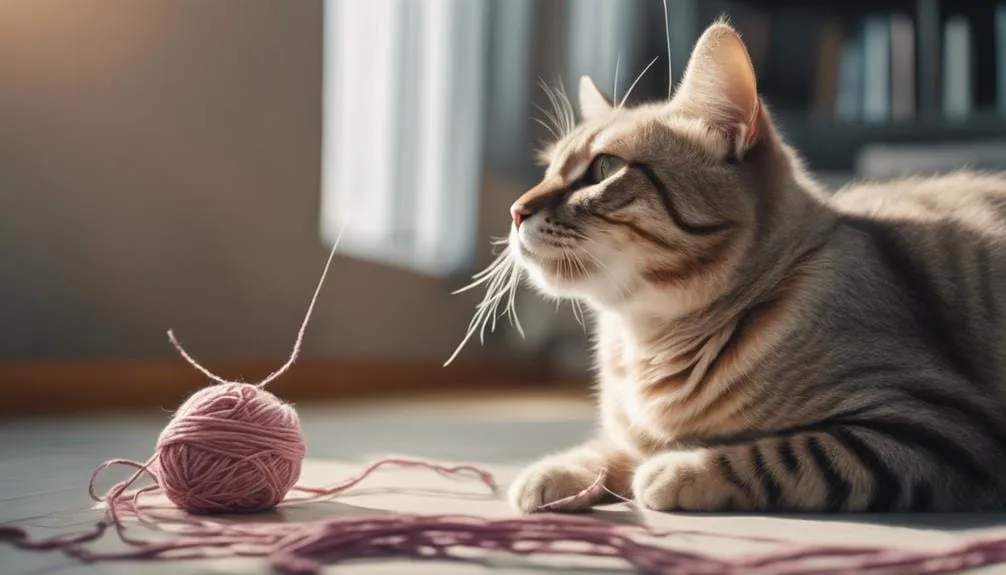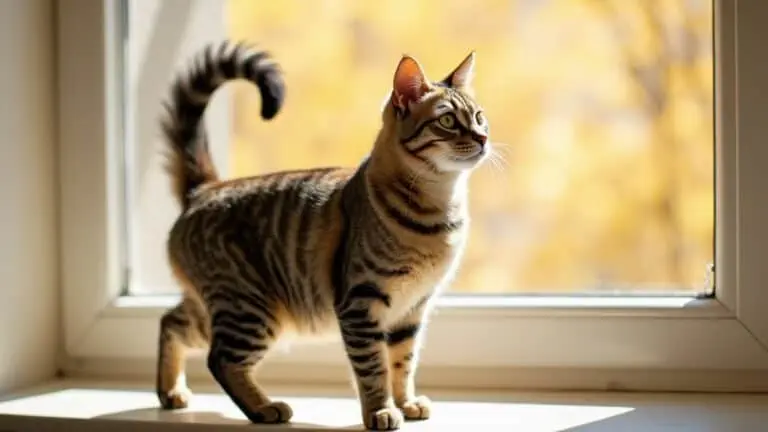The Best Fluffy Pancakes recipe you will fall in love with. Full of tips and tricks to help you make the best pancakes.

Imagine you're in a jungle, surrounded by untamed beasts. Now, picture bringing that same wild spirit into your home in the form of a feral cat.
How do you navigate this uncharted territory and transform your fierce feline into a loving companion? The key lies in understanding the strategies that can help you unravel the mystery behind taming your cat's wild side.
From decoding their behaviors to creating a safe haven, the journey to domesticating your untamed pet is an intricate one. Explore the depths of these effective strategies to pave the way for a harmonious relationship with your furry friend.
Key Takeaways
- Understand and acknowledge your cat's wild instincts to effectively manage their behavior.
- Establish a consistent routine to build trust and provide security for your cat.
- Engage in enrichment activities to prevent boredom and promote mental and physical well-being.
- Use positive reinforcement training to reinforce good behavior and modify unwanted behaviors effectively.
Understanding Your Cat's Behavior
To truly understand your cat's behavior, observe their natural instincts and communication cues closely. Cats, as descendants of wild animals, retain many of their ancestors' behaviors such as hunting, scratching, and marking territory. These instincts are ingrained in their DNA and influence how they interact with their environment. By recognizing these wild animal instincts in your domestic cat, you can better comprehend their actions and needs.
Feline body language, vocalizations, and facial expressions serve as essential tools for deciphering your cat's behavior. Just like their wild counterparts, cats use these forms of communication to express emotions such as affection, aggression, fear, or stress. Understanding these cues allows you to respond appropriately and build a stronger bond with your furry companion.
Socialization, early experiences, and genetics also shape your cat's behavior. While they may have adapted to living alongside humans, their innate traits as wild animals continue to influence how they behave. By acknowledging and respecting these instincts, you can create a harmonious environment that meets your cat's natural inclinations.
Establishing a Routine
To establish a routine for your feral cat, start with consistent meal times and regular play sessions. These predictable interactions help create a sense of security and comfort for your cat.
Consistent Meal Times
Establishing a consistent mealtime routine plays a crucial role in taming your cat's wild side, especially if you're dealing with a feral cat. Feral cats thrive on predictability and security, and regular meal times provide just that.
By feeding your cat at the same times each day, you help build a sense of trust and dependence, making the taming process smoother. Cats are creatures of habit, so a consistent feeding schedule can reduce anxiety and encourage positive behavior.
Additionally, this routine allows you to monitor your cat's health and appetite closely, enabling early detection of any potential issues. Remember, by sticking to a reliable mealtime routine, you aren't just feeding your cat but also nurturing a bond that helps tame their wild instincts.
Regular Play Sessions
Engage your cat in regular play sessions to establish a routine that promotes physical activity and mental stimulation. Consistent playtimes are crucial for your cat's well-being, especially for feral cats, as it helps them feel secure and reduces anxiety.
Here are some benefits of incorporating regular play sessions into your cat's routine:
- Reduces stress and anxiety
- Strengthens the bond between you and your cat
- Prevents behavior issues like aggression and boredom
- Mimics hunting behavior, satisfying natural instincts
- Provides a healthy outlet for energy
Providing Enrichment Activities
To keep your feline friend entertained and mentally stimulated, consider incorporating a variety of enrichment activities. Kittens, in particular, benefit greatly from engaging stimuli to help them develop into well-rounded cats. Start by providing puzzle feeders, interactive toys, and climbing structures to satisfy their natural instincts and keep them active.
Scratching posts, cat trees, and window perches can prevent boredom and encourage exercise, essential for a kitten's growth. Rotating toys and introducing new scents or sounds can keep their minds engaged and prevent behavioral issues later on.
Interactive play sessions with toys like laser pointers, feather wands, or catnip toys not only provide mental stimulation but also strengthen your bond with your kitten. DIY enrichment activities such as hiding treats around the house or constructing a cardboard fort offer mental and physical challenges that are both entertaining and beneficial for your energetic kitten.
Positive Reinforcement Training
When training your cat using positive reinforcement, remember to reward good behavior consistently to encourage desired actions. By associating rewards with specific behaviors, you can build trust and strengthen the bond between you and your cat.
Positive reinforcement training focuses on reinforcing the positive, making it an effective way to shape your cat's behavior.
Rewarding Good Behavior
Rewarding your cat's good behavior through positive reinforcement training is key to fostering a strong and trusting relationship between you and your feline companion.
When implementing positive reinforcement with your cat, consider the following:
- Use of Rewards: Treats, toys, and praise are effective tools to reinforce good behavior.
- Consistency is Key: Regularly reward desired actions to help your cat learn and repeat them.
- Building Trust: Positive reinforcement builds trust and strengthens the bond between you and your cat.
- Behavior Modification: Utilizing positive reinforcement can help modify unwanted behaviors effectively.
- Encouraging Positive Habits: Positive reinforcement training encourages positive habits in your cat over time.
Encouraging Desired Actions
Encouraging your cat's desired actions through positive reinforcement training can lead to a cooperative and fulfilling relationship between you and your feline companion. Positive reinforcement training involves rewarding your cat's good behaviors, like using a clicker or treats, to reinforce positive actions. Cats respond well to this method, associating the behavior with a pleasant outcome and increasing the likelihood of repetition. Consistency is crucial in positive reinforcement training to help your cat learn quickly and effectively. Using a variety of rewards, such as treats, toys, or verbal praise, can make training sessions engaging and enjoyable for your cat. This approach not only teaches desired behaviors but also strengthens the bond between you and your cat, fostering a trusting and cooperative relationship.
| Positive Reinforcement Training | Benefits |
|---|---|
| Rewards good behaviors | Encourages desired actions |
| Increases likelihood of repetition | Builds trust and cooperation |
Building Trust Through Rewards
Consistently reinforcing positive behaviors through rewards is key to building trust with your cat in positive reinforcement training. To effectively implement positive reinforcement, consider the following:
- Timely Rewards: Give treats or praise immediately after the desired behavior.
- Consistency is Key: Be consistent in rewarding good actions to reinforce positive behavior.
- Patience Pays Off: Practice patience as reshaping behavior takes time and dedication.
- Focus on the Positive: Redirect focus to rewarding good actions rather than punishing bad behavior.
- Building Bonds: Positive reinforcement helps strengthen the bond between you and your cat.
Creating a Safe Space
To create a safe space for a feral cat, provide a secure and enclosed room with hiding spots to help the cat feel safe and secure. This room should have a litter box filled with organic potting soil to mimic outdoor conditions and encourage natural behavior. Additionally, using a nightlight can offer comfort during the transition period, reducing stress for the cat. Placing human-scented items in the room will assist the cat in getting accustomed to human presence and scent. Ensure all windows and doors are closed to prevent escape and establish a controlled environment for the taming process.
| Safe Space Essentials | Benefits |
|---|---|
| Secure and enclosed room | Provides a sense of safety and security |
| Organic potting soil in the litter box | Encourages natural behavior |
| Nightlight | Offers comfort and reduces stress |
| Human-scented items | Helps the cat acclimate to human presence |
Creating a safe and nurturing environment is crucial for taming a feral cat's wild side. By following these strategies, you can help the cat feel more at ease and begin the process of building trust and companionship.
Seeking Professional Help
As you progress in taming your cat's wild side, seeking guidance from certified animal behavior counselors can offer invaluable expertise in understanding feral cat behavior and providing essential care tips. These professionals specialize in taming feral cats and can assist you with various challenges you may encounter. Here is how seeking professional help can benefit you:
- Expert Guidance: Certified animal behavior counselors can provide expert guidance on taming feral cats.
- Essential Care Tips: Professionals offer essential care tips and strategies for respecting feral cat boundaries.
- Understanding Behavior: Seek help from experts to understand feral cat behavior and challenges in taming.
- Pregnant Cats: Guidance is available for sheltering pregnant feral cats and discouraging spraying behavior.
- Spaying and Neutering: Importance of spaying and neutering and the impact on taming efforts emphasized by professionals.
Consistency Is Key
Establishing a consistent routine with your feral cat is essential for taming their wild side and building trust. Consistency in feeding times, play sessions, and interactions plays a crucial role in helping your feral cat adjust to a domestic environment.
By providing a stable environment with predictable behaviors, you can help your cat feel secure and reduce anxiety. Regular positive reinforcement, such as treats and praise, for desired behaviors reinforces the taming process and encourages cooperation.
Avoid sudden changes or disruptions in your cat's environment to prevent setbacks in the taming progress and maintain a sense of safety. Consistent handling techniques, like gentle petting and calm interactions, are key to building a bond with your feral cat and promoting socialization over time.
Frequently Asked Questions
What Is the Best Way to Tame a Wild Cat?
To tame a wild cat, focus on behavior modification. Building trust with consistent care and positive interactions is key. Use food as a motivator and create a safe environment. Patience is crucial for this slow process.
How Do You Win Over a Wild Cat?
To win over a wild cat, use effective training techniques. Establish trust through consistent feeding and gentle interactions. Use positive reinforcement like treats and toys, respecting their boundaries. Create a safe environment with hiding spots.
How Do You Tame an Unfriendly Cat?
To tame an unfriendly cat, use training techniques like positive reinforcement with treats and toys. Start slow, respecting their boundaries and signals. Create a calm environment for relaxation. Seek guidance from experts for tailored strategies.
How Do I Stop My Cat From Being so Wild?
To stop your cat from being so wild, engage in play therapy to redirect their energy. Interactive toys, consistent routines, and environmental enrichment help. Use positive reinforcement and seek professional advice if needed. Your efforts can calm your cat.
Conclusion
Congratulations on completing the workshop on taming feral cats!
Remember, understanding your cat's behavior, establishing a routine, providing enrichment activities, using positive reinforcement training, creating a safe space, seeking professional help when needed, and being consistent are key strategies in taming your cat's wild side.
With patience and dedication, you can successfully build a strong bond with your feline friend and help them transition from a feral cat to a loving companion.
Best of luck on your journey!








